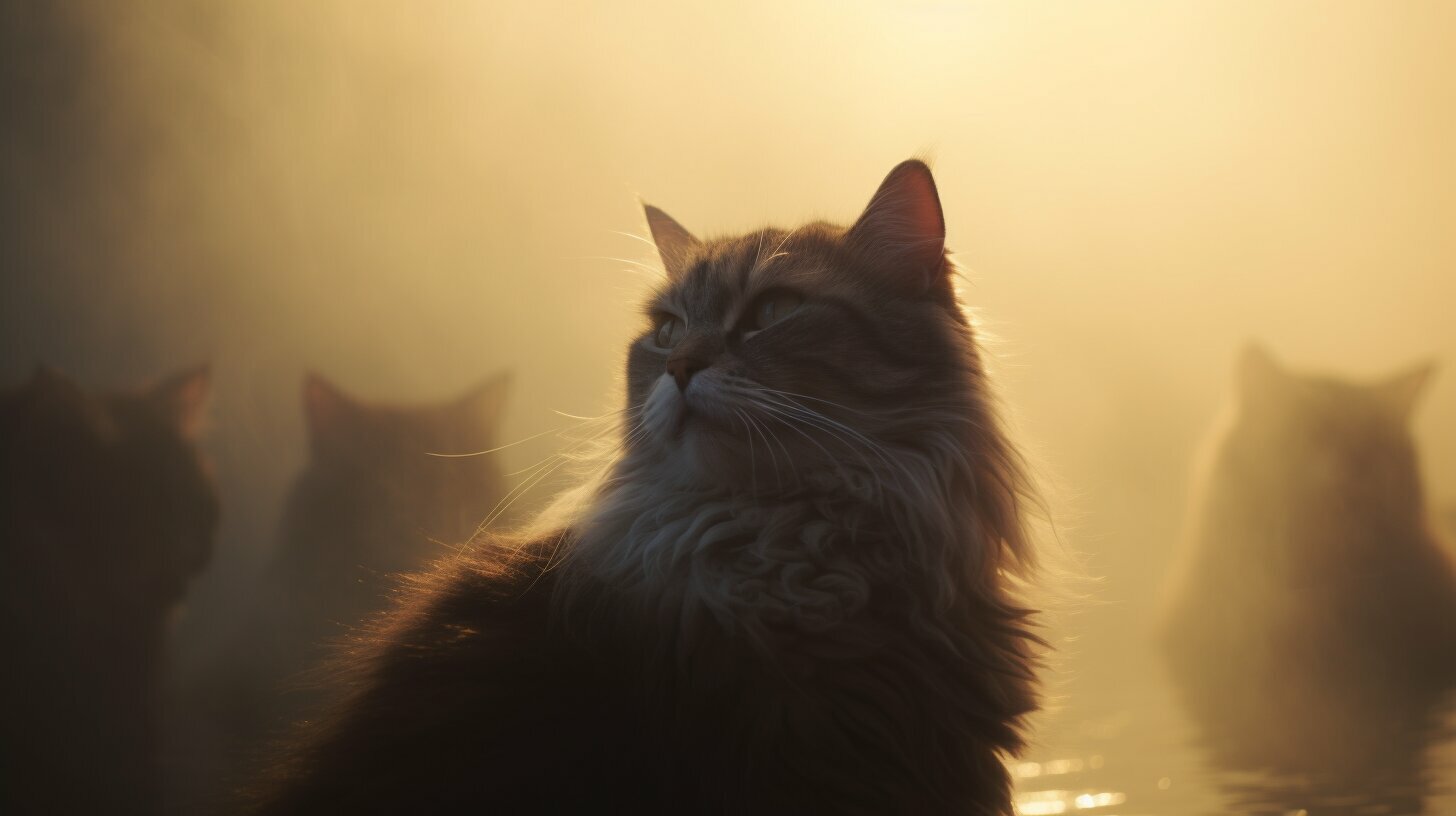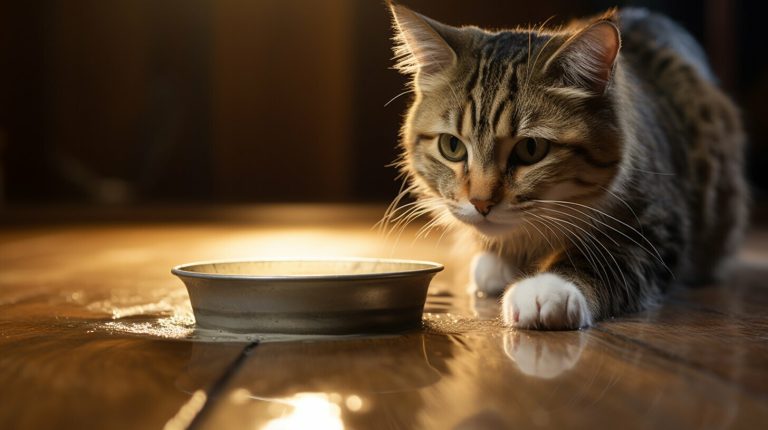Unveiling the Mystery: Why Do Cats Purr When They Are Dying?
Cats possess a fascinating ability to purr, and even in their final moments, this unique feline behavior persists. While the reasons behind why cats purr when they are dying are still not fully understood, it is believed to be a form of communication that goes beyond expressing contentment or happiness. In this article, we will explore the various factors that contribute to this behavior and shed light on its significance.
Key Takeaways:
- Cats purr in various situations, including when they are in pain, fearful, or dying.
- Purring is believed to have healing properties and can promote bone and tissue growth.
- The frequencies of a cat’s purr coincide with established healing frequencies in therapeutic medicine for humans.
- A cat’s purr can have physiological and psychological benefits for human health, such as reducing stress and promoting relaxation.
- The bond between cats and humans is strong, and the purring of a cat can positively impact the well-being of its human companions.
Understanding Cat Purring and Behavior
Before we can unravel the mystery of why cats purr when they are dying, it is essential to understand their purring behavior and the signs that may indicate their declining health.
Cats are known to purr when they are content and happy. It is their way of expressing pleasure and satisfaction. However, purring is not limited to these positive emotions. Cats may also purr when they are in pain, fearful, or anxious. This can make it challenging for cat owners to interpret their furry friend’s purring. It is crucial to observe other signs and behaviors that accompany purring to get a better understanding of what your cat may be experiencing.
Some common signs of a dying cat include decreased appetite, weight loss, lethargy, hiding, difficulty breathing, and changes in litter box habits. If you notice any of these signs along with your cat’s purring, it may indicate that they are nearing the end of their life. It is essential to provide them with comfort and support during this time, ensuring they are as comfortable as possible.
While the exact reasons behind why cats purr when they are dying are still not fully understood, it is believed that the healing properties of purring may play a role. The vibrations produced by a cat’s purr have frequencies that coincide with established healing frequencies in therapeutic medicine for humans. These vibrations can promote bone and tissue growth and may provide some comfort to a cat in their final moments.
What to Do if You Suspect Your Cat is Dying
- Consult with a veterinarian: If you notice any concerning signs or behaviors in your cat, it is essential to consult with a veterinarian. They can provide guidance and support during this difficult time.
- Provide comfort and a peaceful environment: Create a comfortable and calm space for your cat with soft bedding, familiar scents, and minimal noise. Spend quality time with your cat, offering gentle affection and reassurance.
- Monitor their food and water intake: Offer small, frequent meals to ensure your cat stays hydrated and nourished. If they are having difficulty eating or drinking, speak to your veterinarian about possible solutions.
- Consider palliative care options: Depending on your cat’s condition, your veterinarian may recommend palliative care to manage their pain and improve their quality of life. Discuss these options with your vet to determine the best course of action.
Remember, every cat is unique, and their behavior can vary. If you have any concerns about your cat’s wellbeing, it is always best to seek professional advice from a veterinarian.
| Signs of a Dying Cat |
|---|
| Decreased appetite |
| Weight loss |
| Lethargy |
| Hiding |
| Difficulty breathing |
| Changes in litter box habits |
“Cats are mysterious creatures, and their purring behavior can be puzzling. Understanding their purring patterns and recognizing the signs of a dying cat is crucial to providing them with the care and comfort they need in their final moments.” – Dr. Emily Thompson, Veterinarian
The Purpose of Purring in Cats
Purring serves a vital purpose in a cat’s life, providing not only a means of communication but also contributing to their physical well-being. While cats are commonly known to purr when they are content and happy, this behavior extends beyond mere satisfaction. Cats may also purr when they are in pain, fearful, or even nearing the end of their life.
Scientific research has revealed that purring has healing properties and can promote bone and tissue growth in cats. The vibrations produced by purring coincide with established healing frequencies used in therapeutic medicine for humans. These frequencies are believed to have a positive impact on the cat’s overall health, aiding in the healing process and potentially reducing pain and inflammation.
The bond between cats and humans is well-known, and the benefits of a cat’s purr can extend to human health as well. The physiological and psychological effects of a cat’s purr have been found to be beneficial, including reducing stress levels, promoting relaxation, and even lowering blood pressure. The vibrations produced by a cat’s purr create a soothing and calming effect, which can have a therapeutic impact on human well-being.
Understanding the purpose of purring in cats is an ongoing endeavor, as there is still much to uncover about this intriguing behavior. However, it is clear that purring serves as a significant form of communication and plays a crucial role in a cat’s physical and emotional health. So, the next time you hear your feline friend purring, appreciate the multifaceted benefits it brings to both their life and yours.
Purring as a Form of Communication
While commonly associated with contentment, purring is a multifaceted form of feline communication that extends beyond expressing joy. Cats have developed the ability to purr as a means of expressing a wide range of emotions and needs. It serves as a way for them to communicate with both their fellow felines and their human companions.
When a cat purrs, it can indicate that they are feeling relaxed, comfortable, and content. However, purring can also be a sign that they are in pain, fearful, or in distress. It is a method for cats to communicate their emotional state, even in situations where they may not be able to vocalize their feelings.
In addition to using purring as a form of emotional expression, cats also utilize this behavior to communicate their physical needs. For example, a cat may purr to signal hunger or to request attention. By purring, they are able to capture the attention of their human companions and convey their needs nonverbally.
“Purring is a unique way that cats communicate their emotions and desires,” says Dr. Meredith Green, a veterinary expert.
“It’s important for cat owners to pay attention to the specific context in which their cat purrs. By understanding the different meanings behind a cat’s purring, we can better meet their needs and ensure their overall well-being.”
| Context | Meaning |
|---|---|
| Purring while being petted | Contentment and enjoyment |
| Purring during playtime | Excitement and happiness |
| Purring when in pain or fearful | Seeking comfort and reassurance |
| Purring when hungry | Requesting food or attention |
Understanding the various contexts and meanings behind a cat’s purring allows us to deepen our connection with them and respond appropriately to their needs. By observing their body language and paying attention to their purrs, we can develop a stronger bond with our feline companions and provide them with the care and attention they require.
The Healing Power of Purring
Cat purring is not only a means of communication but also possesses fascinating healing properties that can have profound effects on a cat’s well-being. The vibrations produced by a purring cat are believed to promote bone and tissue growth, making purring a potentially therapeutic experience. It’s intriguing to note that the frequencies of a cat’s purr coincide with established healing frequencies in therapeutic medicine for humans.
Research has shown that the vibrations produced by a cat’s purr can have a calming effect, reducing stress and promoting relaxation. The rhythmic sound of a purring cat can create a soothing environment, not only for the cat itself but also for humans nearby. It’s no wonder that many people find comfort in the presence of a purring cat, especially during times of emotional distress or illness.
“When my cat purrs, it’s like a healing balm for my soul,” says Sarah, a cat owner. “It helps me relax and forget about my worries. It’s amazing how such a simple sound can have such a profound impact on my well-being.”
For cats nearing the end of their lives, purring can play a crucial role in providing comfort and solace. As they face physical and emotional challenges, purring allows them to express their emotions and seek reassurance from their human companions. The gentle vibrations generated by a purring cat can create a sense of calm and warmth, making the transition easier for both the cat and their human caregivers.
| Benefits of Cat Purring in End-of-Life Care |
|---|
| Reduces stress and anxiety |
| Provides comfort during painful moments |
| Promotes relaxation and a sense of peace |
| Creates a soothing environment for both cat and caregiver |
The Connection Between Cats and Humans
The connection between cats and humans goes beyond companionship, as the effects of a cat’s purr can extend to improve human health as well. Not only do cats provide comfort and emotional support, but the vibrations produced by their purring have been found to have therapeutic benefits in humans.
Research has shown that the frequencies of a cat’s purr coincide with established healing frequencies in therapeutic medicine for humans. These vibrations have the potential to promote bone and tissue growth, which can aid in the healing process of various medical conditions. The gentle hum of a cat’s purr has even been shown to reduce pain, lower blood pressure, and relieve stress in humans.
Furthermore, a cat’s purring can have a calming effect on the human nervous system. The rhythmic sound and vibrations can induce a state of relaxation, helping to alleviate anxiety and promote better sleep. It is no wonder that many people find the presence of a purring cat to be soothing and comforting.
| Benefits of a Cat’s Purr for Humans: |
|---|
| The vibrations of a cat’s purr can promote bone and tissue growth. |
| It has been shown to reduce pain and lower blood pressure. |
| The rhythmic sound and vibrations can induce relaxation and reduce anxiety. |
| A purring cat can provide comfort and emotional support. |
So, the next time you find yourself in the company of a purring cat, take a moment to appreciate the healing power that lies within their gentle hum. Not only are cats wonderful companions, but their purring can bring about a sense of peace and well-being for both feline and human alike.
The Role of Purring in a Cat’s Final Moments
As cats approach the final moments of their lives, their purring takes on a new dimension, leaving us to wonder why they continue to produce these familiar vibrations. While purring is often associated with contentment, a dying cat’s purr may serve a different purpose. It is believed that purring in this context can be a form of self-soothing, providing them with comfort during their final stages of life.
The sound of a cat’s purr is produced by the laryngeal muscles and is thought to release endorphins, which can help alleviate pain and promote relaxation. In their last moments, cats may be experiencing discomfort or distress, and purring could be their way of coping with these emotions. It is a way for them to find solace and seek comfort as they navigate their journey towards the end.
The Healing Power of Purring
The healing properties of a cat’s purr are also worth mentioning. The vibrations created by the purring frequency range coincide with established frequencies used in therapeutic medicine for humans. It is believed that these vibrations can have a positive impact on bone and tissue growth, which may explain why cats continue to purr even when faced with their own mortality.
Research has shown that the frequencies of a cat’s purr can aid in reducing stress, lowering blood pressure, and promoting relaxation, not only for the cat but also for their human companions. This connection between cats and humans is a testament to the profound bond we share with our feline friends. Their purring becomes a source of comfort and solace, providing companionship and emotional support during difficult times.
| Cats and Purring in Their Final Moments: |
|---|
| “Purring can be a self-soothing mechanism for cats as they approach the end of their lives.” |
| “The vibrations from purring may help cats alleviate pain and find comfort.” |
| “The healing properties of a cat’s purr can benefit both the cat and their human caregivers.” |
| “The bond between cats and humans is strengthened by the physiological and psychological effects of cat purring.” |
Feline Behavior and Emotions in the Face of Death
Cats experience a range of emotions when facing the end of their lives, and understanding their behavior during this time can shed light on the significance of purring. As cats near the end of their lives, their behavior may change in various ways. Some cats become more withdrawn and seek solitude, while others may become more affectionate and seek comfort from their human companions.
In addition to changes in behavior, cats may also exhibit signs of physical discomfort and pain. They may show a decrease in appetite, become less active, or experience difficulty breathing. Despite these challenges, many cats continue to purr as they approach the end of their lives.
While the exact reasons behind this purring behavior are still not fully understood, it is believed that purring may serve as a form of self-soothing. Purring releases endorphins, which can help alleviate pain and provide comfort to cats in their final moments. The vibrations produced by purring may also have a calming effect on the cat’s nervous system, promoting a sense of peace and tranquility.
| Signs of Feline Emotions in the Face of Death |
|---|
| Withdrawn behavior |
| Increased affection |
| Decreased appetite |
| Reduced activity levels |
| Difficulty breathing |
It is important for cat owners to provide a supportive and calm environment during this difficult time. Being present for their cat and offering comfort can help ease their anxiety and provide them with much-needed emotional support. Understanding and respecting a cat’s behavior during the final stages of their life is crucial, as it allows us to honor and cherish their journey.
Conclusion
The enigma surrounding why cats purr when they are dying remains, but one thing is certain – purring holds a profound significance in feline communication and provides comfort in their final moments.
Cats purr as a form of communication, but the exact triggers and meanings behind purring are still not fully understood. While purring is commonly associated with contentment and happiness, cats also purr in other situations, such as when they are in pain, fearful, or dying.
Purring is believed to have healing properties and can promote bone and tissue growth due to the vibrations produced. The frequencies of a cat’s purr coincide with established healing frequencies in therapeutic medicine for humans.
There is a strong bond between cats and humans, and the physiological and psychological effects of a cat’s purr can be beneficial to human health, including reducing stress and promoting relaxation.
FAQ
Why do cats purr when they are dying?
The exact reasons why cats purr when they are dying are still not fully understood. Purring in this context may be a way for cats to self-soothe, express comfort, or communicate their emotional state.
What triggers a cat to purr?
Cats can purr in various situations, including when they are happy, content, in pain, scared, or dying. The triggers for purring can vary depending on the individual cat and the circumstances they are in.
Does purring have healing properties?
Purring is believed to have healing properties. The vibrations produced by a cat’s purr have been shown to promote bone and tissue growth. The frequencies of a cat’s purr coincide with established healing frequencies in therapeutic medicine for humans.
How does a cat’s purr benefit human health?
The physiological and psychological effects of a cat’s purr can be beneficial to human health. It has been shown to reduce stress, promote relaxation, and provide a sense of comfort and companionship.
Can cats purr when they are in pain?
Yes, cats can purr when they are in pain. Purring in this context may be a way for cats to seek comfort or self-soothe. It is important to observe other signs and symptoms to determine the cause of the pain and provide appropriate care.
- Discovering Why Do Women Wear Lipstick: A Deeper Look - 19/12/2023
- Why Do Golfers Only Wear One Glove? - 16/12/2023
- Why Don’t Hobbits Wear Shoes? - 14/12/2023
Hi, I’m Rhiannon, the lead author behind The News Wire. As a passionate journalist, I strive to bring you the latest news and updates from all over the world. With a keen eye for detail and a dedication to unbiased reporting, I aim to deliver well-researched and informative articles that keep you informed and engaged. From breaking news to in-depth analyses, I cover a wide range of topics with the aim of keeping you in the loop. Join me on The News Wire as we explore the dynamic and ever-changing landscapes of global events, uncovering the stories that matter most.






